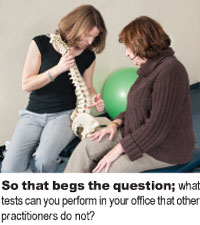 The key to developing a successful practice, one that achieves professional, financial and personal satisfaction, is being able to solve problem cases—the ones no one else has been able to help. The key to solving those problem cases is finding the cause of the problem, and not focusing exclusively on the symptoms. Once the cause is known, the treatment becomes obvious.
The key to developing a successful practice, one that achieves professional, financial and personal satisfaction, is being able to solve problem cases—the ones no one else has been able to help. The key to solving those problem cases is finding the cause of the problem, and not focusing exclusively on the symptoms. Once the cause is known, the treatment becomes obvious.
We are all trained to elicit a careful case history, perform a thorough physical examination, order laboratory tests when necessary, make a diagnosis, develop a treatment plan, and give a report of findings. So that begs the question; what tests can you perform in your office that other practitioners do not?
It is not my intention in this column to short-circuit your present office procedures but, rather, to suggest a few steps, or “tricks of the trade,” if you will, that are easy to perform, quickly done and can be used when needed to put you on the path to discovering the underlying cause of a problem case.
For example, in my last column, I suggested taking one minute (probably 30 seconds) performing a postural analysis. I checked posture on every visit so the patient knew how important it was, and they would check it for themselves at home. This served as a great reactivation incentive.
After checking posture, I had the patient sit on the table and I made two quick observations that hardly anyone else does; I again checked the height of the iliac crests and then checked movement of the head of each clavicle during passive abduction of the arm. These simple tests provided many answers in understanding some very chronic problems that had escaped previous detection.
My patients expected these procedures to be done at each visit, as well as having their weight and blood pressure checked. The point is we must do things that the patient is interested in as well as following our own, often routine, procedures.
Level of Iliac Crests when seated
1. Identify the low hip. Obviously, an unlevel pelvis may be caused by a wallet in a hip pocket. A low hip is often overlooked as a cause of back pain. If you don’t check, how would you know?
2. Did you know it has been guesstimated that an asymmetrical iliac height occurs in 20 to 30% of your patients when they are seated (not including the wallet).
3. Is it possible that this structural problem that occurs every time the patient sits and most doctors never check could be a hidden cause of the patient’s kidney, urinary, reproductive, or bowel elimination symptoms?
4. Of course, detection of this finding immediately suggests that it may be triggering the patient’s back pain, hip pain, knee problems or even chronic shoulder problems that we check next.
Evaluating movement of the clavicle on passive arm abduction
The shoulder is responsive to any structural problem above or below it and I always used this test to roughly gauge the extent of the patient’s structural distortion. I would tell the patient I was grading them as normal, mild, moderate, or severe. I agree that is not very scientific, but it made sense to the patients and was very effective for informing them as to the extent of their problem.
• While you are still standing behind the seated patient, and after quickly checking the relative height of the iliac crests, move your hands to the shoulders.
• When examining the right shoulder, reach your left arm around the front of the patients’ neck and roll your left thumb behind the head of the right clavicle at the sternoclavicular articulation. With your right arm, passively abduct the patient’s right arm past 90 degrees.
• The head of the patient’s right clavicle should be felt to move posterior and inferior into the patient’s chest as the arm reaches and passes 90 degrees.
• Normal movement of the head of the clavicle indicates normal sternoclavicular and glenohumeral function.
• Normal movement of the head of the clavicle when the patient has shoulder symptoms indicates we are dealing with a rather mild problem.
• However, normal movement is often accompanied by an audible “click” at the sternoclavicular articulation that both the patient and the doctor can hear. This indicates shortening of the ligaments that bind the two bones together. I would grade this as a moderate problem.
• I graded lack of movement of the head of the clavicle during passive abduction of the arm as severe or advanced shortening of the ligaments. In the absence of shoulder symptoms, the true cause will be found elsewhere.
Perhaps the next time you are confronted with a patient who is not responding as well as you would like, you will consider a quick postural evaluation, then have the patient sit and evaluate the relative height of the iliac crests and passive movement of the sternoclavicular joint. In my next column, June 2010, I will describe a quick screening procedure for eliminating pathology with the Triangle Test.
Dr. Loomis can be reached by mail at 6421 Enterprise Lane, Madison, WI 53719 or by phone at 1-800-662-2630.Visit his website at http://www.loomisenzymes.com.
